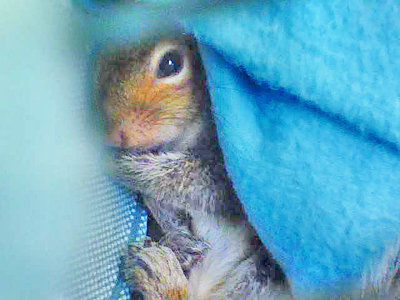
A tiny fawn lay alone in the middle of the road. For hours, drivers maneuvered around her on the driveway leading to a camp off Zayante Road, ignoring the 4-pound animal with the swollen eyes. No one stopped to help her. They were too busy going to a camp event that day.
Where was her mother? Had a car hit her? Was she lying in a ravine dying from her wounds?
Finally, a driver stopped and directed traffic around her. Justin, a tow truck driver for Ladd’s in Felton, had seen many dead dogs and cats on the roads. He had made a commitment to himself that he would always stop and help any injured animal.
He squatted down and the little fawn got up and walked to him, falling into his arms. Picking up the sad little body, he got into his truck and headed to Ladd’s. Sometime later, his girlfriend arrived to pick up the animal and take her to Native Animal Rescue, where Mollie, the founder, waited.
Mollie placed the baby in a box with blankets and a heating pad hanging down the side to warm her. Cold from shock and in pain, the fawn could no longer lift her head.
After 20 years of rescuing wildlife, Mollie knew deep inside that it was probably too late to save her. During the night, the little fawn died.
Animal rehabilitators sometimes experience the bad side of human nature, but Mollie says, “The best part of human nature comes through our door.”
A luckier baby squirrel, later named Pumpkin, was found by a homeowner at the base of a redwood with a broken leg. After a call to Native Animal Rescue, Barbara from Boulder Creek, an experienced squirrel rescuer, picked her up. At her home, she placed the foundling in a “receiving blanket” and began the arduous task of nursing her back to health, starting with a trip to the veterinarian for an X-ray.
Baby squirrels have to be fed every few hours, and with her broken leg, Pumpkin needed constant attention. So Barbara, a therapist, took Pumpkin with her everywhere she went, including work.
At first, the baby could not move her leg, but one day, Barbara noticed Pumpkin wiggling her toes. She was on her way to recovery.
Although rehabbers work hard not to put a human “imprint” on wildlife, the bond that Barbara had with Pumpkin became special. The squirrel overwintered with her, as she needed extra time to heal.
When spring came, Barbara began the process of “wilding up” — when the rehabber puts the animal in a cage outdoors for a month to acclimate it to the temperature and build up its muscles for life in the wild.
Eventually, the cage is left open during the day and closed at night when the animal returns. This is called a “soft release” and usually happens two days before the new moon, when the darkness protects the animal from predators. Eventually, the animal does not return.
The first thing a newly-released squirrel will do is make a nest for itself. In the evening, when Barbara would call out “Pumpkin!” she would hear the leaves twisting on the branches, and down would come the squirrel to sleep in the enclosure. But one night, Pumpkin did not come back.
Twice a day, when Barbara fed her neighbor squirrels, she looked for Pumpkin. She would be easy to spot among the other squirrels because she was smaller, with bigger eyes and feet. No Pumpkin.
But one morning, 18 months later, when Barbara opened her door to give the squirrels their breakfast of walnuts, peanuts and sunflower seeds, she saw a little squirrel waiting for her on the deck railing.
“Pumpkin, you’re back!” she exclaimed. “And you’re having babies!” she noted, looking at the squirrel’s swollen nipples.
Since their reunion, Pumpkin stops by twice daily to eat from Barbara’s special squirrel buffet.
An important note
If you find a sick or injured wild animal, please do not try to rehab it yourself. Put it in a box with air holes and bedding, and keep it warm but do not place it on a heat source. Do not give the animal food or water.
Then, call Native Animal Rescue at 462-0726 and deliver the animal to 1855 17th Ave. in Santa Cruz. If you need the animal picked up, leave a message.
Carol Carson, an environmental activist, writes an occasional nature column for the Press-Banner. She has been a docent for Henry Cowell Redwoods State Park and taught courses on Big Basin State Park for University of California, Santa Cruz, Extension. She can be reached at ca****@*********on.com.












